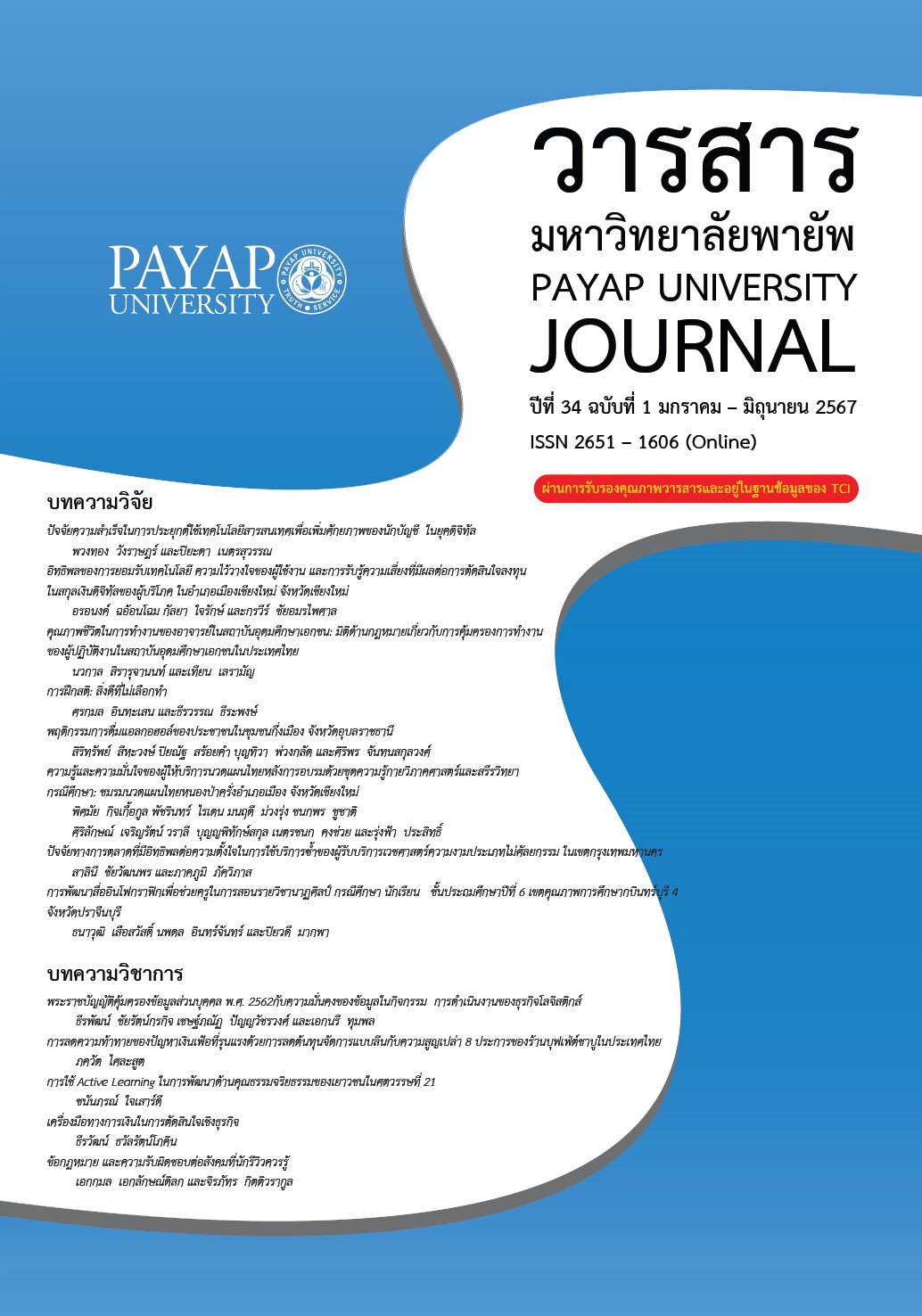เครื่องมือทางการเงินในการตัดสินใจเชิงธุรกิจ
Main Article Content
บทคัดย่อ
เครื่องมือทางการเงินในการตัดสินใจเชิงธุรกิจโดยใช้ข้อมูลที่ใช้ในการวัดมูลค่ายุติธรรม ตามมาตรฐานการรายงานทางการเงิน ฉบับที่ 13 แบ่งข้อมูลที่ใช้ในการวัดมูลค่ายุติธรรมออกเป็น 2 ประเภท คือ 1) ข้อมูลที่สามารถสังเกตได้จากตลาดและข้อมูลที่ไม่สามารถสังเกตได้จากตลาด ลำดับชั้นมูลค่ายุติธรรม (Fair Value Hierarchy) 2) ข้อมูลที่มีความสม่ำเสมอและสามารถนำมาเปรียบเทียบได้ ในมาตรฐานการรายงานทางการเงิน ฉบับที่ 13 ซึ่งกำหนดให้ต้องเปิดเผยลำดับชั้นมูลค่ายุติธรรม 3 ระดับ ประกอบด้วย ระดับที่ 1 ระดับที่ 2 และระดับที่ 3 ตามประเภทของข้อมูลที่นำมาใช้ ในการคำนวณระดับข้อมูล (Levels of Inputs) ระดับที่ 1 ราคาเสนอซื้อขายในตลาดคล่องหรือราคา ปิดตลาดของหลักทรัพย์ที่มีลักษณะเหมือนกัน ระดับที่ 2 ข้อมูลที่สามารถสังเกตได้จากตลาด เช่น ราคาเสนอซื้อขายของสินทรัพย์หรือหนี้สินที่คล้ายคลึง และระดับที่ 3 ข้อมูลที่ไม่สามารถสังเกตได้จากตลาดอย่างมีนัยสำคัญจึงต้องมีการประมาณการจากกิจการ ประกอบด้วย การวัดมูลค่าเงินลงทุนที่ไม่มีตลาด การให้ความน่าเชื่อถือ การเปิดเผยลำดับชั้นมูลค่ายุติธรรมช่วยเพิ่มความน่าเชื่อถือของข้อมูลการวัดมูลค่าการประยุกต์ใช้ การวัดมูลค่ายุติธรรมที่มีระดับข้อมูลต่าง ๆ ช่วยในการประเมินค่าทรัพย์สินและหนี้สินอย่างมีประสิทธิภาพ ทำให้ข้อมูลสามารถเปรียบเทียบได้ และช่วยลดความไม่แน่นอนในการตัดสินใจ ทางการเงินของนักลงทุนและผู้เกี่ยวข้อง
Article Details
เอกสารอ้างอิง
ณดน พัฒนวณิชย์กุล. (2555). ผลกระทบของการเปิดเผยข้อมูลตามลำดับชั้นมูลค่ายุติธรรมต่อวิจารณญาณของนักลงทุนทั่วไป. [วิทยานิพนธ์บัญชีมหาบัณฑิต, มหาวิทยาลัยธรรมศาสตร์]. Thammasat University Digital Collections. https://digital.library.tu.ac.th/tu_dc/frontend/Info/item/dc:110139
วิศรุต ศรีบุญนาค. (2559). Fair value measurement. https://account.cbs.chula.ac.th/2016/
/19/%E0%B8%81%E0%B8%B2%E0%B8%A3%E0%B8%A7%E0%B8%B1%E0%B8%94%E0%B8%A1%E0%B8%B9%E0%B8%A5%E0%B8%84%E0%B9%88%E0%B8%B2%E0%B8%A2%E0%B8%B8%E0%B8%95%E0%B8%B4%E0%B8%98%E0%B8%A3%E0%B8%A3%E0%B8%A1/
Ahmed, A. S., Kilic, E., & Lobo, G. J. (2011). Effects of SFAS 133 on the risk relevance of accounting measures of banks' derivative exposure. The Accounting Review, 86(3), 769-804. https://publications.aaahq.org/accounting-review/article-abstract/86/3/769/3358/Effects-of-SFAS-133-on-the-Risk-Relevance-of?redirectedFrom=fulltext
Barth, M. E., Beaver, W. H., & Landsman, W. R., (2001). The relevance of the value relevance literature for accounting standard setting: Another view. Journal of Accounting and Economics, 31(1-3), 77-104. https://www.sciencedirect.com/science/article/abs/pii/S0165410101000192
Bleck A. & Liu X., (2007). Market transparency and the accounting regime. Journal of Accounting Research. 45(2), 229-256. https://onlinelibrary.wiley.com/doi/abs/10.1111/j.1475-679X.2007.00231.x
Carroll, T. J., Linsmeier, T. J., & Petroni, K. R. (2003). The reliability of fair value versus historical cost information: Evidence from closed-end mutual funds. Journal of Accounting, Auditing & Finance, 18(1), 1-23. https://www.researchgate.net/publication/228199504_The_Reliability_of_Fair_Value_vs_Historical_Cost_Information_Evidence_from_Closed-End_Mutual_Funds
Clor-Proell S. M. & Warfield T. (2009). Financial statement presentation and nonprofessional investors' interpretation of fair value information. University of Wisconsin-Madison. https://www.researchgate.net/publication/228436212_Financial_statement_presentation_and_nonprofessional_investors'_interpretation_of_fair_value_information
Dietrich, J. R., Harris, M. S., & Muller, III. K. A. (2000). The reliability of investment property fair value estimates. Journal of Accounting and Economics, 30(2), 125-158. https://ideas.repec.org/a/eee/jaecon/v30y2000i2p125-158.html
Elizabeth B., Thomas J. , Kathy R. P. & Catherine S. (2013). Fair value accounting for financial instruments: Does it improve the association between bank leverage and credit risk. American Accounting. 88(4), 1143-1177. https://papers.ssrn.com/sol3/papers.cfm?abstract_id=1565653
EYGM Limited. (2022, December 8). Applying IFRS fair value measurement. https://www.ey.com/en_tw/tax/tax-alerts/applying-ifrs-fair-value-measurement
Hirst, D. E., Hopkins, P. E. & Wahlen, J. M. (2004). Fair value, income measurement, and bank analysts' risk and valuation judgments. The Accounting Review, 79(2), 453-472. https://papers.ssrn.com/sol3/papers.cfm?abstract_id=451381
Hsu, P. H. & Youan, R. L. (2009). The FVO and Firms’ Earnings Management Incentives. California State University. https://papers.ssrn.com/sol3/papers.cfm?abstract_id=2559996
Jory, C. I. (2016). "Dialogue and reflection: understanding the differences". 30, 145–165 https://www.academia.edu/11313820/Negotiation_and_Deliberation_Grasping_the_Difference
Koonce, L., Nelson, K. K., & Shakespeare, C. M. (2011). Judging the relevance of fair value for financial instruments. The Accounting Review, 86(6), 2075-2098. https://publications.aaahq.org/accounting-review/article-abstract/86/6/2075/3326/Judging-the-Relevance-of-Fair-Value-for Financial?redirectedFrom=fulltext
KPMG. (2022, December 8). Measuring fair value in times of change. https://kpmg.com/xx/en/home/services/audit/international-financial-reporting-standards/ifrs-toolkit/ifrs-us-gaap-fair-value-measurement.html
Landsman, W. R. (2007). Is fair value accounting information relevant and reliable? Evidence from capital market research. Accounting and Business Research, 37(sup1), 19-30. https://www.tandfonline.com/doi/abs/10.1080/00014788.2007.9730081
McGill, A., & Tenbrunsel, A. (2000). Mutability and propensity in causal selection. Journal of Personality and Social Psychology, 79(5), 677-689.
Nelson, K. (1996). Fair value accounting for commercial banks: An empirical analysis of FAS No.107. The Accounting Review, 71(2), 161-182.
Patricia M. Dechow a, Linda A. Myers b 1, Catherine Shakespeare. (2001). Fair value accounting and gains from asset securitizations: A convenient earnings management tool with compensation side-benefits. Journal of Accounting and Economics, 49(1-2), 2-25.
Petroni, K. & Wahlen, J. M. (1995). Fair values of equity and debt securities and share prices of property-liability insurer. Journal of Risk and Insurance, 62(4), 19-37.
P-y curve model of weak rock. (2022). https://www.pilegroups.com/single-post/p-y-curve-model-of-weak-rock-reese-1997
Song, C. J., W. B. Thomas, & Yi, H. (2010). Value relevance of FAS No. 157 fair value hierarchy information and the impact of corporate governance mechanisms. The Accounting Review, 85(4), 1375-1410.


